Onychomycosis is an insidious disease because many people are unaware of the initial symptoms and turn to experts for help when the disease is actively progressing. At this stage, it is impossible not to pay attention to these signs. The nails begin to collapse and peel off, the inflammation spreads to the skin, and the nearby areas become inflamed. To act in time, you need to understand the appearance of toenail fungus.
Nearly two thirds of the world's population have to face the manifestation of fungal infections. Onychomycosis or nail damage is not only an aesthetic problem; in the later stages, the disease starts to cause physical discomfort.
Onychomycosis is difficult to treat. If measures are taken at an early stage, the disease will respond better to treatment. For this, you need to know what a nail affected by fungus looks like.
Disease description
Fungal diseases that affect nails are called onychomycosis. The fungus penetrates into the plate and destroys keratin-the basis of the nail plate. Fungal spores enter the intercellular spaces and begin to multiply rapidly.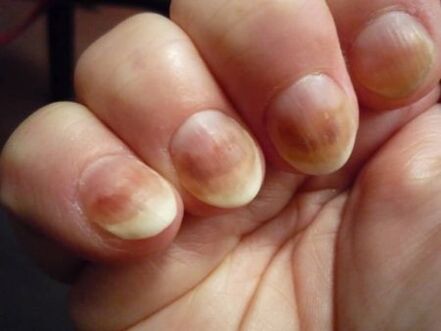 If the infection is not treated, then the disease can affect the nails, and if there is not enough treatment, it can spread to nearby skin areas.
If the infection is not treated, then the disease can affect the nails, and if there is not enough treatment, it can spread to nearby skin areas.
infection
Fungal spores exist in the environment. They are highly resistant to external influences, and the spores will not die even at temperatures below zero. However, fungi can only actively multiply in a warm and humid environment. Therefore, people face the greatest risk when going to public baths, swimming pools, and gyms.
If one of the visitors is infected with onychomycosis, the fungal spores still exist on the things he has touched and remain active for a long time. These spores can affect the skin and nails of healthy people. To "infect" an infection, walking barefoot on the floor with fungal spores is enough.
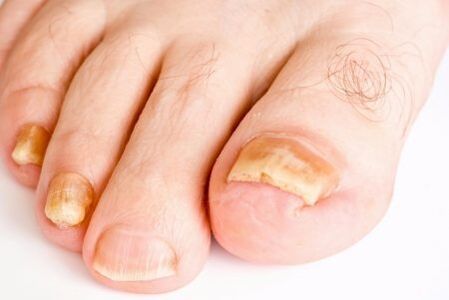
Suggest! Wooden surfaces are particularly dangerous-floors, shower grilles, benches. The fact is that the tree has a porous structure, even if it is thoroughly disinfected, it cannot destroy the spores of pathogenic microorganisms.
But, of course, not every "encounter" with a fungus ends in disease. In most cases, the body's immune system will successfully fight the infection. But if the body is weak or the person does not follow basic hygiene measures, then the possibility of suffering from onychomycosis will increase.
Factors that contribute to the development of the disease
In order for the fungus to begin its permitted activity, certain conditions must be met. In most cases, the elderly are susceptible to this disease and their immune systems are weak. Therefore, onychomycosis is more common in the elderly than in the young. Risk factors:
- Do not follow hygiene rules, wear tight shoes, clothes and shoes made of synthetic materials;
- Any damage to the skin, even a small scratch, is a "gateway" to infection;
- Pathology of the endocrine system;
- Chronic diseases that weaken the immune system;
- Long-term use of drugs, especially hormones, cytostatics and antibiotics.
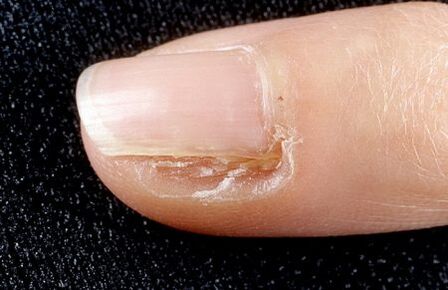
Suggest! You can get onychomycosis with a manicure or pedicure in a beauty salon. If the master does not pay attention to the disinfection of the instruments, the file of the knife will become the source of infection.
The pathogen of the disease
So far, about 50 fungi that can cause onychomycosis have been identified. Therefore, you should not self-medicate. If the disease is caused by another type of pathogen, then drugs that are effective for one type of nail fungus may be useless.
The complication of treatment is that the infection is not located on the surface of the nail, but under the nail plate. Therefore, the use of topical drugs does not always achieve the desired effect. If left untreated, the disease will continue to develop. Furthermore, the more the disease starts, the more difficult it is to cure it.
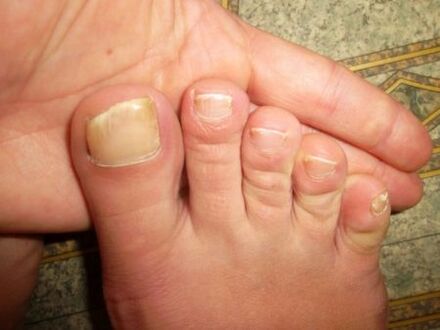
Onychomycosis often appears on the legs. The infection can affect the nail of the first toe, but over time, it can spread to other nails. Fungus on the hands is less common, but this disease should not be considered rare.
clinic
Symptoms depend on the form and stage of the lesion, so it is impossible to answer the question of what the fungus on the nail looks like.
The most common situation
The initial stage is called normal nutrition. At this stage, the performance is darker, so many patients don't pay attention to it. In most cases, you can see the following signs:
- Lose transparency
- The appearance of yellow spots, most often on the outer edge;
- Sometimes a "gap" is formed between the nail and the nail bed.
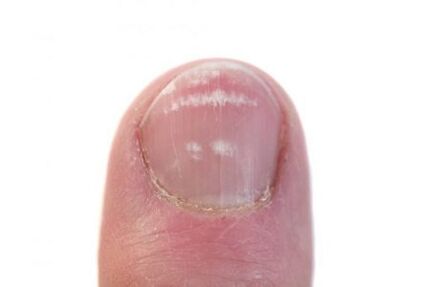
Such lesions are called distal lesions and are the most common. If there is no treatment, the process begins. Subungual keratosis appeared. This phenomenon is characterized by increased growth of keratinocytes and therefore thickened nails.
Suggest! Hyperkeratosis is the normal response of nails to infection. In addition, the deeper the infection penetrates the nail plate, the thicker the nail becomes.
In the later stages, complete damage to the deck was noticed and signs of malnutrition appeared. Gradually, the substrate is also involved in this process-where the nails grow. At this stage, there is no result even if the nail is removed, because the patient's nail plate has already begun to grow.
Surface form
In the initial stage, white spots appear on the nails of this form. Over time, they will grow and occupy the entire surface of the nail. The plate becomes loose and rough. If you scratch your nails with a hard object, the scales will begin to separate.
Suggest! This form of fungal disease only occurs on the toes, most commonly in the big finger, and rarely in the little finger.
Proximal subgap
In this form, the affected nail looks like this:
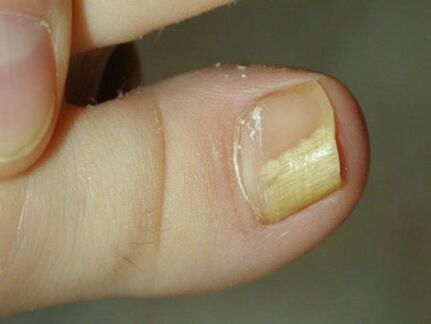
- The tissue around the nail turns red and becomes inflamed;
- The drum swells and becomes painful;
- The cuticle begins to separate from the nail;
- The nail appears dystrophic changes, first grooves appear on the steel plate, then brittleness, and the late plate disappears.
Types of fungi
The manifestation of the disease also depends on the type of pathogen. Of course, only through testing can the type of pathogen be accurately determined. The external signs are also different, but the symptoms are still not diagnosed:
- Dermatophytes. Fungi of the genus Dermatophytes feed on keratin, that is, they "attack" the hair, nails, and upper stratum corneum. About 40 such fungi are known, but onychomycosis only causes about 12 pathogens. The source of infection is the patient, and you can get infected through direct contact or using ordinary objects. Streaks and spots first appear on the affected nail, then the edge of the nail gradually turns yellow and gradually lags behind the nail bed. The larger the spot area, the higher the degree of infection.
- Yeast. These are pathologies caused by Candida fungi. This type of pathogen is opportunistic. That is, there are a certain amount of fungus on the surface of the skin and nails, but as the immunity declines, the fungus begins to multiply and cause inflammation. When the nail is damaged, the plate will gradually become thinner, yellow, and then brown, lagging behind the nail bed. With this type of infection, nail folds can be severely affected. They can become red, swollen, and painful.
Suggest! Usually, fungal infections develop gradually. Usually, this disease will last for several years without entering the advanced stage. But when the nail plate is affected by yeast fungi, the disease progresses very quickly.
- Mold. The infection caused by mold is confined to the top of the plate and does not penetrate deep into the plate. Therefore, this type of onychomycosis is easier to treat than other types. The first sign of damage is a change in the color of the nail plate. In addition, the nail acquires an unnatural color, and it can turn green or black. In the initial stage, black spots appear on the nails and gradually develop into spots. Over time, the entire plate will change color.

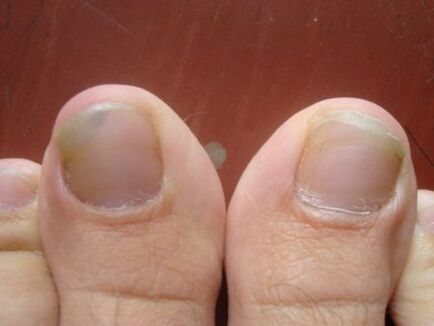
If onychomycosis is not treated, the pathogen will transfer to the skin of the foot, causing dermatophytes. In this case, symptoms such as itching and cracks in the skin will appear. It is painful for the patient to walk in shoes.
what should I do?
What should you do if you see signs of a fungal infection? Self-medication is not worth it. You should see a dermatologist. The expert will prescribe the test and make an accurate diagnosis. Parents of children need to be especially careful. Of course, in children, nail fungus is not often observed, but this disease can occur at any age.
Remember, the earlier treatment is started, the easier it is to deal with the disease. If you start treating fungal infections at an early stage, you can use topical treatments-ointments, solutions. But you will have to receive treatment that lasts for several weeks.

In the late stage, not only ointments, but also systemic drugs, namely tablets, are needed. Such drugs are taken orally from the digestive tract, and the active substance is absorbed into the bloodstream and carried throughout the body with the bloodstream. Therefore, the infection will be destroyed from the inside.
At any stage of the disease, strengthening the immune system is very useful. If necessary, immunomodulators will be prescribed by a specialist. The patient needs to establish a rest plan, sleep more, and walk every day. You also need to monitor your diet. The "favorite food" of fungi is sugar. Therefore, you need to minimize the amount of sweets in your diet.
Therefore, understanding what nail fungus on hands and toes looks like is useful for everyone. This knowledge will help to detect signs of disease in time and start treatment at the earliest stage. This will allow you to quickly cope with the disease and eliminate the need for systemic drugs that have a negative effect on the liver.
























